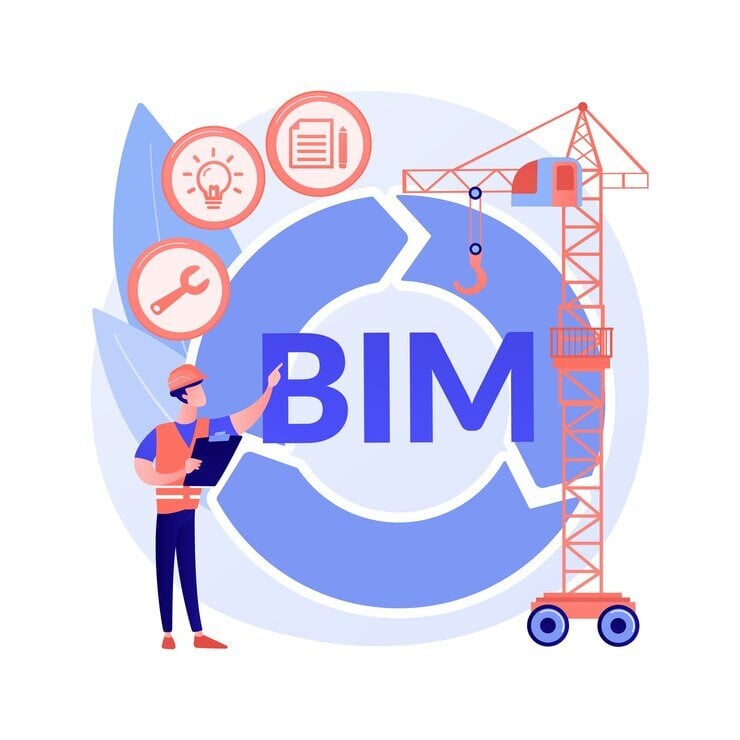The Impact of BIM on Civil and Structural Engineering

Table of Contents
In the dynamic world of civil and structural engineering, the tangent of Building Information Modelling(BIM) has ushered in a transformative era of the Architecture, Engineering, and Construction (AEC) industry. The growing use of BIM in civil and structural engineering is allowing professionals to manage design, planning, and construction tasks with greater clarity and accuracy. Civil engineering is often considered one of the most complex jobs in the AEC industry. Evaluating if a design is good to build, ensuring that drawings are precisely executed on-site, managing material procurement, and handling site safety- it’s a manifold role that requires agility and strength. To shoulder these responsibilities well, it is essential that civil engineers turn to technology for help. Cutting-edge tools and processes such as Building Information Modelling (BIM) are changing the landscape of the civil engineering profession for the better.
BIM stands as a digital paradigm shift that is revolutionising the traditional approaches to design, construction, and project management. This process integrates various facets of a building’s lifecycle into a 3D digital model, allowing stakeholders better insights and collaboration opportunities. In this blog, we will dive into how BIM impacts civil and structural engineering and is reshaping the AEC industry.
What is BIM for Civil and Structural Engineers?

BIM for civil and structural engineers is a transformative digital process that involves creating and managing 3D models of buildings, bridges, roads, and other infrastructure projects. BIM incorporates detailed information about the physical and functional characteristics of the project components. This information-rich model allows engineers to visualise and simulate the entire lifecycle of a project, from initial design through construction to maintenance and renovation.
BIM for civil engineers allows professionals to accurately plan and design infrastructure projects, optimising everything from road alignments to drainage systems. Likewise, BIM for structural engineers allows them to create detailed structural models. It helps them assess the structural integrity of buildings and bridges, simulate various load scenarios, and identify potential issues before the actual construction begins. Some of the most popular and best BIM software for civil engineers include Bentley MicroStation, Tekla Structures, and Revit.
Read: Revit MEP: Its Benefits and the Revolution of BIM workflows
9 Benefits of BIM for Civil and Structural Engineers

BIM isn't merely a trend; it's a paradigm shift that offers numerous advantages to professionals in the field. Let’s explore the key benefits of BIM for civil and structural engineers:
1. Enhanced Collaboration
BIM for civil and structural engineers fosters collaboration among multidisciplinary teams involved in construction projects. Civil and structural engineers, architects, contractors, and other stakeholders can work within a shared digital environment, eliminating confusion and enhancing communication. This collaboration ensures everyone is on the same page, reducing errors and rework.
2. Accurate and Realistic Visualisations
One of the standout benefits of BIM for civil and structural engineers is its ability to create accurate 3D models of buildings and infrastructure. This allows professionals to visualise projects in detail even before the construction begins. This also helps identify potential issues early in the design phase, allowing for timely adjustments and prevention of costly errors during construction.
3. Clash Detection and Conflict Resolution
Software that supports BIM, incorporates clash detection capabilities that automatically identify clashes between different design elements. BIM for civil and structural engineers can detect and resolve conflicts in plumbing, electrical systems, structural components, and more. Projects can stay on schedule and within budget by addressing these issues before construction.
4. Improved Cost Estimation
BIM for structural engineers allows the creation of accurate cost estimates by providing a comprehensive view of the project. It includes detailed information about materials, quantities, and labour requirements. Accurate cost estimates help stakeholders make informed decisions, avoid budget overruns, and ensure the project remains financially viable.
Also Read: 8 Benefits of BIM for Structural Engineers

5. Sustainable Design and Analysis
Sustainability is a growing concern in building construction and infrastructure projects. BIM tools allow civil and structural engineers to analyse the environmental impact of their designs. They can optimise energy efficiency, water usage, and material choices, helping create more eco-friendly structures. BIM also aids in obtaining green building certifications like IGBC (Indian Green Building Council) and LEED (Leadership in Energy and Environmental Design) by helping analyse building performance and energy efficiency.
6. Streamlined Documentation
BIM for civil engineers simplifies the documentation process. Professionals can automatically generate construction documents, drawings, and reports directly from the digital model. This reduces the time and effort required for paperwork, leaving more room for design refinement and quality control.
7. Efficient Communication
BIM allows professionals to work on projects in real-time ensuring that all stakeholders are aware of design changes, thereby promoting coordination and reducing the chances of costly errors stemming from outdated information. This minimises disruptions, preserving project continuity and client satisfaction.
8. Better Facility Management
Once a project is completed, BIM for civil and structural engineers continues to provide value. It is a comprehensive database of information about the building or infrastructure, making maintenance and facility management more efficient. Engineers can access information about equipment, materials, and maintenance schedules, facilitating long-term sustainability.
9. Compliance and Regulations
BIM software often includes features that help engineers stay compliant with local building codes, simplifying the approval process and mitigating risks related to non-compliance. Engineers can confidently navigate regulatory hurdles, ensuring projects proceed smoothly within legal frameworks.
6 Applications of BIM in Civil and Structural Engineering

BIM has evolved from a mere design tool to a comprehensive solution for planning, designing, constructing, and managing infrastructure projects. Mentioned below are ways in which civil and structural engineers can harness BIM.
1. Enhanced Design Visualisation
One of the fundamental applications of BIM for civil and structural engineers is creating detailed 3D models of buildings with accurate dimensions, materials, and structural elements. Civil and structural engineers can use BIM to visualise their projects more comprehensively and intuitively. Professionals can explore different design options, evaluate their impact on the project's performance, and make informed decisions early in the design phase.
2. Improved Collaboration and Coordination
With BIM, architects, engineers, contractors, and subcontractors can work on a shared platform, reducing conflicts and errors caused by miscommunication. BIM's cloud-based collaboration features enable real-time data sharing and document management. This ensures that all team members have access to the most up-to-date project information, reducing the risk of costly mistakes during construction.
3. Clash Detection and Conflict Resolution
There's a higher chance of design clashes and conflicts in complex projects, such as large infrastructure developments.BIM for structural engineers can automatically detect clashes between different building components and systems. This allows civil and structural engineers to address issues before construction begins, minimising costly revisions and project delays. This results in a more efficient and cost-effective project, benefitting all stakeholders.

4. Accurate Bill of Quantities
BIM for civil and structural engineers assists in generating precise quantity takeoffs and cost estimates. The software can extract data directly from the 3D model, reducing the likelihood of manual errors and discrepancies. This level of accuracy is highly valuable when preparing project budgets and bids.
5. Streamlined Construction and Project Management
Once construction begins, BIM continues to play a vital role in project management. It provides a platform for tracking project progress, managing resources, and scheduling activities. BIM for structural engineers also facilitates the creation of detailed construction documentation, including drawings and specifications that contractors can reference throughout the construction process.
6. Facility Management and Maintenance
The benefits of BIM for civil engineers extend beyond construction. After a project is completed, the 3D model becomes a great asset for facility management and maintenance. Civil and structural engineers can use BIM to keep a digital record of the building's components, systems, and maintenance schedules. This enables proactive maintenance and reduces long-term operational costs.
3 Challenges of Using BIM for Civil and Structural Engineering

BIM has undoubtedly transformed the civil and structural engineering landscape, offering a plethora of advantages. However, like any technology, BIM comes with a set of challenges that engineers need to address to harness its full potential.
1. Data Complexity and Management
BIM projects generate vast amount of data, including 3D models, drawings, specifications, schedules, and more. Managing this extensive dataset can be overwhelming and can often lead to inefficiencies. Therefore, project stakeholders should implement a robust data management strategy. They must utilise BIM software that offers efficient data organisation features and establish clear naming conventions and folder structures for files. Additionally, consider using a common data environment (CDE) to centralise project information, ensuring all team members can access the latest data.
2. Interoperability Issues
Collaboration among different stakeholders often involves various software platforms and tools, which may only sometimes seamlessly integrate. This can result in data loss, translation errors, and miscommunication. To address these challenges, it is essential to prioritise interoperability when selecting BIM software. Opt for platforms that support industry-standard file formats, such as Industry Foundation Classes (IFC), for seamless data exchange. Also, establish clear communication protocols among project participants to ensure everyone understands the software's limitations and requirements.
3. Skill and Training Gaps
Transitioning to BIM for civil and structural engineers demands them to acquire new skills and adapt to a different workflow. Resistance to change and a lack of training can hinder successful BIM implementation. Hence, investing in comprehensive training programs can be a viable option for engineering professionals. Enrolling in workshops, courses, or programs that provide you with knowledge about practical applications of BIM can help boost your career. This can foster a sense of continuous learning and growth, which is essential to succeed in a dynamic and ever-evolving industry.
Future Trends of BIM in Civil and Structural Engineering
As digital tools grow more advanced, the future of BIM in civil and structural engineering is moving toward smarter, more connected workflows. These trends are expected to improve accuracy, reduce delays, and support better long-term asset performance.
1. Digital Twins Becoming Standard
More projects will use digital twins, real-time virtual replicas of structures, to monitor performance, predict issues, and guide maintenance.
2. Greater Use of AI and Automation
AI tools will help engineers detect errors faster, automate modeling tasks, and generate improved design options.
3. Cloud-Based Collaboration
Cloud platforms will allow teams to work on the same model at the same time, improving transparency and reducing version conflicts.
4. Sustainability and Carbon Modeling
BIM tools will continue to integrate carbon analysis and energy modeling to support sustainable design decisions.
5. Stronger Government Mandates
More public projects will require BIM at different stages of design and construction, making BIM skills essential for future engineers.
Overall, these trends show how BIM is moving from a design tool to a full lifecycle solution, supporting safer, more efficient, and environmentally responsible infrastructure.
In Conclusion
BIM is not just a technological advancement; it's a transformative tool that empowers civil and structural engineers to excel in their roles. By embracing BIM, engineers can enjoy enhanced collaboration, improved design and visualisation, streamlined workflows, and efficient conflict resolution. Embracing BIM is not just a choice; it's a strategic move towards a more efficient, accurate, and collaborative future in engineering.
BIM continues to transform how civil and structural engineers plan, collaborate, and deliver projects. With technology evolving quickly, gaining strong BIM skills is increasingly important for staying competitive in 2026 and beyond.
To learn how to use BIM, you must check out the BIM Professional Course for Civil Engineers by Course by Novatr. It is a practice-based course that equips professionals with industry skills. Explore the course today!
Also, visit our Resource page to learn more about the latest trends in the AEC industry.
Frequently Asked Questions
1. What is BIM in civil and structural engineering
BIM is a digital process that helps engineers design, plan, and manage buildings and infrastructure using detailed 3D models. It improves accuracy and coordination across project stages.
2. How does BIM improve collaboration in engineering projects?
BIM allows all team members to work from the same updated model, reducing confusion and making communication faster and clearer.
3. What are the main benefits of BIM for engineers?
The biggest benefits include better visualization, accurate quantities, fewer design clashes, easier documentation, and smoother construction workflows.
4. What challenges do engineers face when adopting BIM?
Common challenges include handling large amounts of data, software compatibility issues, and the need for proper BIM training.
5. What is the future of BIM in the construction industry?
BIM will expand through digital twins, AI automation, sustainability modeling, and government BIM requirements for major public projects.

 Thanks for connecting!
Thanks for connecting!




.png)


.jpg)
